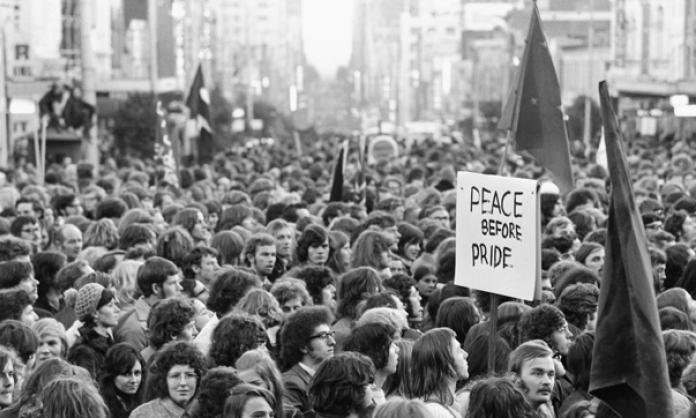With the Liberals back in office, there needs to be a dramatic change in the orientation of activists if we are to have any hope of stopping climate disaster.
The mainstream environmental groups pinned their hopes to the federal election, by and large campaigning uncritically for Labor. The Australian Youth Climate Coalition was typical, its main slogan being, “Pledge to Vote Climate: This election, our future in on the line. Add your name and show that action on climate change will shape how you vote on May 18”.
In the face of the Liberals’ victory, these organisations have been demoralised and have opposed protests called by more radical groups such as Extinction Rebellion.
But focusing on electoral politics was always a dead-end strategy. The giant energy and mining companies that make tremendous profits from fossil fuels – and the broader capitalist class that backs them – were never going to allow their polluting industries to be shut down by a mere election.
They are going to have to be forced to take action by a mass disruptive movement on the streets, in the schools, on university campuses and above all in the workplaces. Only such a determined movement will have any hope of stopping them in their tracks.
Even if the Liberals had been defeated, Labor’s policy on the climate emergency was pathetically inadequate and represented no serious threat to the big polluters. Labor would not even commit to the most minimal measures, such as stopping the Adani coal mine.
So whereto from here?
We can draw some important lessons from the response of activists to a comparably demoralising electoral defeat, that of the 1966 federal election.
Back then, the Vietnam War was being escalated and the Liberals had imposed conscription to compel young men to fight and die to maintain imperialist domination. Though no radical, the Labor leader of the day, Arthur Calwell, still had some principles, unlike Bill Shorten or Anthony Albanese. He campaigned forcefully against conscription and Australian involvement in the war during the election campaign.
The main anti-war groups – the women’s group Save Our Sons and the largely campus-based Youth Campaign Against Conscription – threw themselves into campaigning for Labor.
However, because of lingering Cold War anti-communism, the war remained broadly popular. The Liberals unleashed a shamelessly racist campaign, including advertisements depicting white Australians working as Harbour Bridge “coolies” for their new Asian masters and brochures warning of the “yellow hordes” that featured huge red arrows pointing down from China through Vietnam to Australia.
Labor was smashed in the election, its vote falling by 5 percent to its lowest level since the 1930s. This shattering defeat shocked activists and proved a turning point for the anti-war movement.
Just as it has done after this election, Labor responded to the loss by moving to the right and watering down its opposition to the war. Calwell was dumped as leader and replaced by the “modernising” right-winger Gough Whitlam, an enthusiastic supporter of the US alliance.
At Whitlam’s urging, the 1967 federal ALP conference dropped any call for the immediate withdrawal of conscripts from Vietnam. Jim Cairns, the leading figure in the parliamentary Labor left, and the NSW ALP Left Steering Committee acquiesced in Whitlam’s rightward shift.
The right appeared triumphant. There seemed no prospect that the barbarous war could be stopped.
Many campaigners dropped out of activity demoralised. But for those determined to fight on, it was clear that the parliamentary road to stopping the war was closed off. They had to come up with a new approach.
The right’s electoral victory quickly proved to be less total than it seemed. Cracks were appearing in the edifice of the Cold War consensus. As Bob Dylan had prophetically put it some years earlier, a new mood was “blowing in the wind”.
The anti-war movement was on the defensive during most of 1967, but an opinion poll in November showed that only 37 per cent supported the recent increase in Australian troops in Vietnam to 8,300 – the largest military force Australia had sent overseas since World War II.
There was thus a basis for an anti-war movement. A core group of activists recognised this and shifted to the left. Their orientation was to build a mass movement to stop the war via direct action. As Labor ducked for cover, the party became less of a pole of attraction for those politicised by the war, and the focus moved away from electoralism.
Police assaults on demonstrators hastened the radicalisation. Cops broke up demonstration after demonstration and protesters were frequently bashed in police cells, an experience which more often than not strengthened their resolve.
Victorian Police commissioner Rupert Arnold gave these tactics the green light, commenting: “If there is any moral rot eating at the mode of life we call Western civilisation, the British type police forces of the world must stand firmly against it. [The police’s] most dangerous opposition comes from people who want to change the world suddenly and dramatically. [The] right of arrest [is] his main weapon to be used with all the physical force he can muster, all the determination at his command to neutralise the hostile, obstructive acts of louts, whether allegedly educated or otherwise”.
This authoritarian approach failed to stop the growing protests, and a generation of student activists and some workers started to see that the state was not a neutral body regulating society for the common good, but an instrument of class rule for the rich and powerful.
Sizeable protests greeted the visit of South Vietnamese dictator air vice-marshal Ky to Australia in the summer of 1966-67, and the protests became more radical politically, open support being expressed for the “enemy” – the Vietnamese National Liberation Front (NLF). On the campuses, students began collecting money to aid the NLF, which brought howls of condemnation from politicians, the press and “respectable” society.
In 1968, in part inspired by the revolts that rocked the world in that glorious year, the Australian anti-war movement really took off. It became more defiant and confrontational.
Draft resisters began to get more organised, with the newly formed Draft Resistance Movement declaring: “The DRM has not been formed to oppose conscription, it has been formed to wreck it. We are opposed to the war in Vietnam and we intend to resist the conscription of Australian youth for this war by all available means”.
Demonstrations and sit-ins were staged at government buildings. Then, in May 1968, the government attempted to compel universities to provide confidential information on students eligible for conscription. A sensational report in the student union paper National U described the response: “Unparalleled eruptions of mob violence have bloodied the eastern seaboard of Australia in the last 48 hours with students rioting uncontrollably in both Melbourne and Sydney in scenes of mass insurrection unmatched in the last generation”.
On US Independence Day, 4 July 1968, rioting demonstrators attempted to storm the US consulate in Melbourne. For several hours, a pitched battle raged between mounted police and the 4,000-strong crowd. Fifty-five people were arrested, and 1,500 marched to Russell Street police station to demand their release. Baton charges were used to try to break up the crowd, and the battle raged into the night.
The more radical mood amongst protesters was underpinned by and intersected with a rising tide of worker militancy. 1969’s sweeping general strike forced the release of union official Clarrie O’Shea, jailed for defying harsh anti-union laws.
The protests were also beginning to have an impact on broader public opinion. By August 1969, opinion polls for the first time showed a majority in support of withdrawing troops from Vietnam.
But public opinion was not enough to shift the Liberal government and the wider ruling class from its pro-war stance. Ongoing, defiant mass action was needed.
The movement peaked with the Moratorium marches in May 1970. More than 100,000 people took part in sit-downs in the streets of Melbourne, and tens of thousands marched in other cities. Student protesters were joined by many thousands of striking workers.
It took real commitment to join the Moratorium in the face of incredible hysteria by Liberal politicians, the media and police. They denounced the protesters as traitors and “pack-raping bikies”, and threatened them with vicious police assault and mass arrests.
But the defiance paid off. The government was forced to retreat and promise the partial withdrawal of troops. Just a few short years after a demoralising electoral loss, a major war was being wound down in response to a radical mass movement.
It is this sort of defiance we need again today if we are to have any hope of stopping climate disaster and bringing those responsible – on both sides of parliamentary politics – to heel. We have one major advantage today in that the mass of people already recognise the urgent need for serious action to combat climate change.
However, passive sentiment won’t be enough to save us. Sentiment needs to be galvanised into action. Determined protests and acts of civil disobedience can begin to lay the basis for a radical mass movement that can rock the whole of capitalist society to its foundations. With climate vandals in parliament, we need to turn demoralisation into action and take the streets. There is no time to lose.











